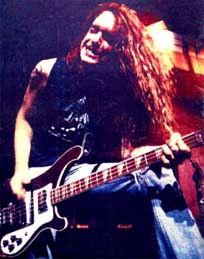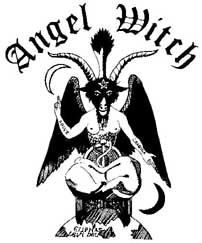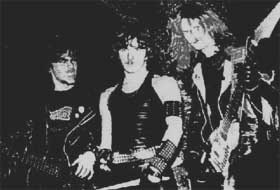Metal aged and so did the generation that produced the hippies, drifting into commercialdom and then self-hatred for losing sight of basic goals. Having lost both of their fundamental systems of iconography (traditional + hippie "revolution" and New Left) within a decade while most of the population remained ignorant to both, the youth of the 1960s and 1970s were more cynical and materialist as they aged than any previous group. This awakened a scavenger coming to carcass in the 1980s which rolled into glorious rehash of the commercial ambition of the 1950s, leading to a wave of denial and an ever-present conformity in face of new fears: drugs, technological warfare, disease.
A desperate paranoid climate emerged underneath the murmuring denial neurosis of commercial social doctrine. Ideology in popular music became an intense moral crusade of horror at the history of humanity to that point, hearkening back to WWI-era dissent. In this environment, metal updated itself with the aggression and simplicity of hardcore, and came back for the attack in at first two hybrid genres: speed metal and thrash.
 Speed metal took the classically-influenced structures of neoclassical progressive heavy metal from the 1970s and merged them with the palm-muted, choppy strum of violent British hardcore, as well as the whipping speed-strum of the more fluid crustcore genre. An example of the first influence can be found in violently alienated bands like The Exploited and Black Flag, where the latter originated in Amebix and Discharge, who twisted three chords into a song where the guitar playing was fast but the drumming and vocal delivery slower, creating like ambient music a disorientation of pace and thus of activity. Thrash was crossover music based more in hardcore, so unlike speed metal, which added hardcore riff stylings to metal song forms, it added metal riff stylings to hardcore song forms.
Speed metal took the classically-influenced structures of neoclassical progressive heavy metal from the 1970s and merged them with the palm-muted, choppy strum of violent British hardcore, as well as the whipping speed-strum of the more fluid crustcore genre. An example of the first influence can be found in violently alienated bands like The Exploited and Black Flag, where the latter originated in Amebix and Discharge, who twisted three chords into a song where the guitar playing was fast but the drumming and vocal delivery slower, creating like ambient music a disorientation of pace and thus of activity. Thrash was crossover music based more in hardcore, so unlike speed metal, which added hardcore riff stylings to metal song forms, it added metal riff stylings to hardcore song forms.
Classic speed metal bands were Metallica, Megadeth, Testament, Slayer, Anthrax and Prong, but these were the largest and most commercial and many others existed concurrently. Thrash remained underground and lasted for less than a decade, thus it retained its primal trio of Cryptic Slaughter, the Dirty Rotten Imbeciles and Corrosion of Conformity, although it is academically interestin to mention offshoots like Suicidal Tendencies and Fearless Iranians From Hell, both of which were more punk rock and rock'n'roll than the core of the thrash genre. Although toward the end of the 1980s people began referring to bands like Destruction and Kreator as "thrash metal," it makes more sense to identify them as essentially speed metal bands which borrowed attributes from thrash and nascent death metal bands.
 At one point praised by Robert Fripp for remaining apart from mainstream culture, these bands faced a growing divide in the music industry, namely the availability of cheaper recording technology (thanks to advances in digital and manufacturing ability) as well as, for the first time, the ability to press records and CDs in small runs, giving rise to a horde of smaller labels. While hardcore punk bands had maintained the DIY aspect for years, they were unwilling and unable to make any money doing so, but in the 1980s the ease of access to these technologies meant that small, independent ("indie") labels could both publish ecclectic rarities and not go bankrupt in the process.
At one point praised by Robert Fripp for remaining apart from mainstream culture, these bands faced a growing divide in the music industry, namely the availability of cheaper recording technology (thanks to advances in digital and manufacturing ability) as well as, for the first time, the ability to press records and CDs in small runs, giving rise to a horde of smaller labels. While hardcore punk bands had maintained the DIY aspect for years, they were unwilling and unable to make any money doing so, but in the 1980s the ease of access to these technologies meant that small, independent ("indie") labels could both publish ecclectic rarities and not go bankrupt in the process.
For youth growing up during this time period, life was an uncertain and duty-bound prospect, threatened on one side by ICBMs which could arrive in a matter of minutes and vaporize cities, and on another by a tide of reactionary politics and social conformity which forced people into norms to avoid the risk of standing out and being tacitly avoided by employers and potential social contacts alike. Speed metal and thrash bands, who were in the crux of generational exchange, experienced both worlds: the public image and the private reality, including political dissidence.
 Their hardcoresque anthems of social and political dissent are leftist but even more so, "rejectivist." The world is pushed back and its mechanisms declared incompetent. Many began the slow spiral into fatalism, where either through belief in religious mechanisms behind historical growth or a lack of ability to apply their passion, lapsing into a hedonism of self-destructive principle. The hedonistic attitudes and hail-satan paeans to deviant creativity evaporated as a politicized theory of what ought to be done, inherited both from hardcore punk and the surrounding public culture, seized metal. Songs were written about the evils of drugs, the mistreatment of American Indians, the oppression of minorities by a WASP majority, the desire for individualist independence from the conformist horde, and the abuse of our natural environment.
Their hardcoresque anthems of social and political dissent are leftist but even more so, "rejectivist." The world is pushed back and its mechanisms declared incompetent. Many began the slow spiral into fatalism, where either through belief in religious mechanisms behind historical growth or a lack of ability to apply their passion, lapsing into a hedonism of self-destructive principle. The hedonistic attitudes and hail-satan paeans to deviant creativity evaporated as a politicized theory of what ought to be done, inherited both from hardcore punk and the surrounding public culture, seized metal. Songs were written about the evils of drugs, the mistreatment of American Indians, the oppression of minorities by a WASP majority, the desire for individualist independence from the conformist horde, and the abuse of our natural environment.
At its inception a genre of palm-muted, Morse-codish riffs and epic song structures the speed metal of the 1980s held out until the 1990s before being absorbed. Speed metal and "social consciousness" dimmed many fantasies; it had become as moralistic as both the conservative society and self-righteous countermovement against which 1969 metal had rebelled. This caused dissent among those who felt that both commercialism and this moralistic trend were absorbing the "free spirit" they had admired in the music previously, and that it was becoming predictable and self-destructive in its tendency to sound like everything else. In contrast, electronic music was exploring increasingly existential themes and broader questions of intent, eschewing the moralistic humanism which overran speed metal and thrash.
This conflict led to change in the form of the rise of metal's dual underground genres, which by 1987 had established themselves in nascent form as a handful of ideas and techniques each. These would await another generation to be brought into much focus, as the transitional time of the end of the 1980s and the dominant liberalism of the early 1990s caused further ideological confusion in metal (and essentially eliminated punk hardcore as an artform, since it drowned in the same ideological conformity). At first, these two genres were the same musical formation, but over time differences in scope and belief separated them.
 Early bands which explored this new territory fused the melodic, elemental speedy hardcore of Discharge or The Exploited with the more architectural song forms, as developed initially by bands like Judas Priest and Angel Witch, and added to them an emphasis on chromatic intervals, both for their simplicity and the dead sound they gave to any melodic temperment to the song as a whole. After Discharge's "See Nothing, Hear Nothing, Say Nothing" came out in 1982, metal responded the following year, with new bands Bathory, Sodom and Hellhammer developing morbid Goth-Romantic versions of the new style, embracing death and evil and nothingness, as if channeling the apocalyptic thermonuclear fears of the previous generation of metal into a certainty of existential doom. Their essential thesis seemed to be thus: the world had become obsessed with its own power and political-moral attitudes, but had forgotten the finity of human life and thus the need to pick things that were important and eternal, such as nature and strong emotions, which had been obscured by the need to avoid threats and defend against philosophical enemies.
Early bands which explored this new territory fused the melodic, elemental speedy hardcore of Discharge or The Exploited with the more architectural song forms, as developed initially by bands like Judas Priest and Angel Witch, and added to them an emphasis on chromatic intervals, both for their simplicity and the dead sound they gave to any melodic temperment to the song as a whole. After Discharge's "See Nothing, Hear Nothing, Say Nothing" came out in 1982, metal responded the following year, with new bands Bathory, Sodom and Hellhammer developing morbid Goth-Romantic versions of the new style, embracing death and evil and nothingness, as if channeling the apocalyptic thermonuclear fears of the previous generation of metal into a certainty of existential doom. Their essential thesis seemed to be thus: the world had become obsessed with its own power and political-moral attitudes, but had forgotten the finity of human life and thus the need to pick things that were important and eternal, such as nature and strong emotions, which had been obscured by the need to avoid threats and defend against philosophical enemies.
In the mainstream, Slayer produced their own version of this style in 1983, but did not differentiate much beyond a fusion of Judas Priest, Angel Witch and Discharge until their album of 1987, "Raining Blood." By that time, Celtic Frost had emerged from Hellhammer with a mock operatic drama of searching for value in T.S. Eliot's wasteland, Bathory had unleashed a Viking rock spectacular which identified strongly with the heroic values of ancient societies, and Sodom had gone from praising Satan to warning of environmental holocaust and dicatorship. Further bands had joined the fray, most notably Sepultura, Possessed and Massacra, each of whom added a degree of interpretation of a style coming to be known as death metal. Of note also were Necrovore and Morbid Angel who created similar styles of acerbic, abstract death metal.
No comments:
Post a Comment
Please Comment with Respect and don't write about SARA